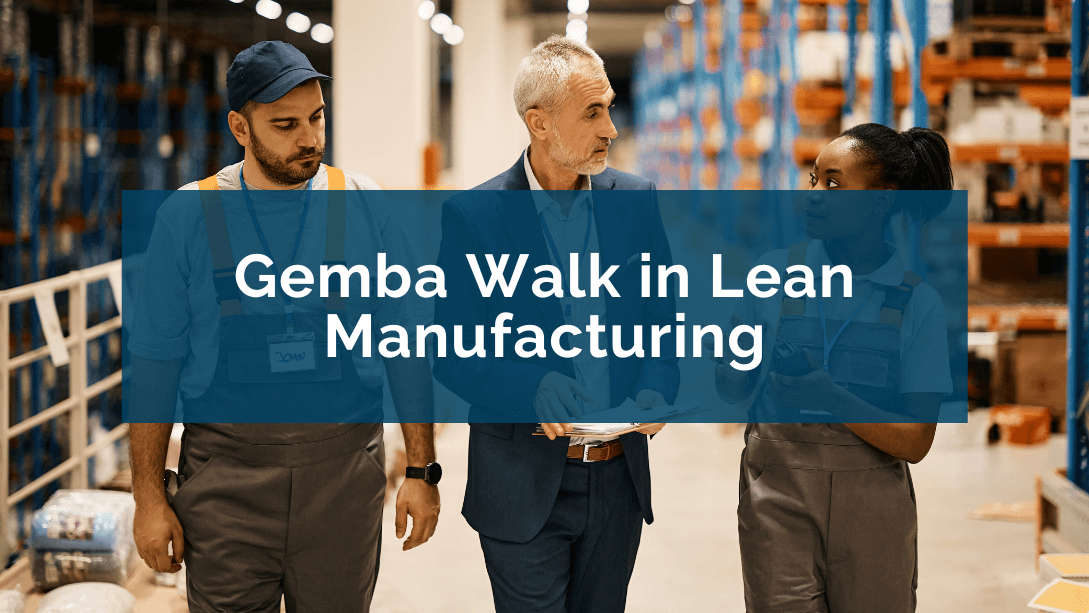What is a Gemba Walk?
The Japanese term "Gemba", sometimes spelled "Genba", means "the actual place" where reality is. In other words, Gemba refers to where work is done and value creation occurs. In Lean Manufacturing, this word refers to the shop floor – the production environment, where operations come to life and problems can be observed without filters.
Developed by Taiichi Ohno at Toyota, the key concept of Gemba is closely aligned with the foundations of the Lean production system. It’s part of the broader family of continuous improvement methodologies and is related to Genchi Genbutsu ("go and see for yourself"), which encourages leaders to go directly on site to witness concrete facts rather than stay in a meeting room with abstract reports.
Because Gemba Walks is so close to the factory floor, it allows managers to zoom in on operational processes, interact with teams, and identify opportunities for improvement in real time.
The Gemba Lean Manufacturing methodology provides valuable insights for identifying waste, streamlining operations, and strengthening operational discipline. It then becomes a means to continuously improve processes and overall business performance.
Benefits of Gemba Walks in Lean Manufacturing
From improving efficiency and worker safety to strengthening team communication and strategic alignment, the significant benefits of Gemba Walks extend across every level of the organization.
Deep understanding of operations
Direct observation of work processes allows managers to gain valuable insights to accurately identify inefficiencies, bottlenecks, and waste that can be invisible in reports alone. This enables them to make informed decisions and set consistent priorities.
Responsiveness and quick problem-solving
Being on-site means seeing live what's wrong and acting accordingly. The problem is addressed immediately and can’t get worse. By enabling action as soon as anomalies are detected, Gemba Walks reduce rework, time-consuming shutdowns, and waste.
Better communication and team engagement
Gemba Walks bridge the gap between management and frontline workers by initiating an honest dialogue on the factory floor, linking strategy to day-to-day tasks. Such communication not only breaks down silos but also values human input and transparency. Open conversations and employee feedback strengthen engagement and motivation.
Improved workplace safety and employee well-being
Regular Gemba Walks provide a detailed look at the work environment to better identify potential risks and conditions that require improvement. By quickly correcting situations and behaviors representing a safety hazard, companies proactively reduce incidents, strengthen safety and improve employee well-being.
Alignment between strategy and operations
Gemba Walk plays a crucial role in helping management teams and leaders align strategic and operational objectives to bring their vision to life. At the same time, this initiative helps teams better understand the impact and purpose of their actions, which increases productivity and engagement.
Standardization of best practices
Gemba Walks are critical for identifying the most effective practices on the factory floor. As part of a Gemba Lean Manufacturing approach – or a more broadly Lean Management approach – these optimized processes and procedures are standardized and shared, ensuring greater business process consistency and increased workforce performance.
Examples of Gemba Walks in manufacturing companies
Here are some examples of Gemba Walks carried out in manufacturing and industrial organizations:
-
Quality control: A quality-focused Gemba Walk ensures product excellence throughout the production process. By directly inspecting workstations, a manager can identify recurring defects and immediately discuss them with the team. This approach allows for quick problem-solving and increases product reliability.
-
Inventory management: A manager visiting the warehouse can observe congested areas and unbalanced stock levels. With this knowledge, they can make concrete adjustments to streamline logistics and reduce losses.
-
Production line: The manager can identify bottlenecks slowing down the entire production line throughout the manufacturing process. With such observations, they can quickly implement corrective measures to eliminate waste, optimize the production cycle, and increase throughput.
-
Safety: By scrutinizing operators' daily actions, the leader notices a risky posture at a workstation. This direct analysis encourages discussion with workers and the research and implementation of safer practices in a better-protected environment.
7 Steps to implement Gemba Walks in your plant

1. Define the objectives
Before walking the shop floor, you need to know why you’re conducting a Gemba Walk. Define clear goals – identify wasteful activities, strengthen health and safety, or enhance product quality. These objectives will guide what must be checked during Gemba visits (e.g., compliance with standards, workstation organization, access to equipment, etc.).
2. Prepare and plan the route
The Gemba Walk shouldn't be done randomly. Establish a structured itinerary, choose the right times throughout the day, and collect existing data (from operational dashboards, stream maps, manufacturing KPIs, etc.) to guide your observations.
Define the duration and frequency. A Gemba Walk takes about 20 to 60 minutes and must be regularly carried out to have a real impact. Depending on the manager's role and the organization's maturity, the Gemba Walk can be performed daily, weekly, or monthly.
Finally, create a Gemba Walk checklist with the questions you want to ask and the items to check based on your objectives.
3. Inform teams to build trust
It’s crucial to inform in advance employees who will be involved in the Gemba Walk. Explain that the goal is to learn, not to criticize. Talk to them about the process so they feel confident and willing to collaborate. Discussions with employees should be constructive and transparent.
Share your checklist. By asking your colleagues for their perspective, you may be able to identify overlooked items, blind spots, or specific elements you hadn't anticipated during preparation.
4. Lead the walk and observe with an open mind
When conducting Gemba Walks, prioritize listening and observation: observe without interrupting, ask open-ended questions, and focus on the actual process – not on individuals. Avoid any criticism on the spot.
5. Record observations with rigor
Carefully document your observations (dysfunctions, waste, non-conformities, etc.) and any employee feedback. Take notes and add photos as needed to facilitate analysis and prioritize actions.
6. Analyze findings to plan actions
After the Gemba Walk, make time to debrief with your teams to identify the potential causes of the problems observed. Propose both short-term and long-term actions, involving employees every step of these continuous improvement initiatives.
7. Ensure follow-up and regularity
To ensure successful implementation, Gemba Walks must be conducted regularly as well as closely monitored. Schedule recurring Gemba visits, track progress, and adjust your approach to embed continuous improvement into your company’s Lean Management routines.
Best practices for a successful Gemba Walk process
From planning steps before a Gemba Walk to managing corrective actions after the walk, these best practices allow everyone involved to get the most out of the Gemba Walk:
Define a theme
A Gemba Walk must have a clear objective. This makes it possible to target specific questions and checkpoints, ensuring a more thorough observation of each related aspect.
Respect the work in progress
Remember that the Gemba Walk is not an inspection or an audit. The manager must show a sincere interest in the tasks accomplished and value their employees’ expertise. Respect and consideration are essential conditions for building trust.
Actively involve employees
Gemba Walks are a time for exchange and shared learning. Managers must actively listen and encourage their teams to share constructive feedback and suggest continuous improvement ideas. In Lean Manufacturing, the best solutions often come from those working on the factory floor every day.
Vary schedules and routes
It’s strongly recommended to vary the days, times, and areas observed to avoid falling into a routine. This allows you to view operations in different contexts and provides a more comprehensive overview.
Use Gemba Walk software
In addition to listening and observing, taking notes and recording observations is essential. Using a digital tool like UTrakk to document gaps, assign actions, and track progress helps speed up resolution of problems affecting operational performance and continuous improvement.
Increase the impact of your Gemba Walks with UTrakk
The digitalization of Gemba Walks with dedicated software increases effectiveness of such Lean activities. With UTrakk DMS, these floor tours are transformed into structured, well-managed, and results-driven management rituals.
UTrakk facilitate:
-
Structure and regularity: The solution lets you plan regular, structured floor tours that include personalized checklists to ensure nothing is left to chance.
-
Quick gap identification: Using these Gemba Walk checklists, managers have a clear framework for detecting anomalies, waste, or risks directly on the shop floor.
-
Implementation of action plans: Each observed problem can immediately trigger an action assigned to an owner, with a specific deadline. This ensures rigorous monitoring and effective resolution of gaps.
-
Real-time monitoring: The data collection is centralized in dashboards, providing instant visibility into obstacles encountered, the status of operations, and the progress of KPIs.
Turn your Gemba Walks in a performance and continuous improvement driver
Managers who want to make a real impact on performance and operational excellence must be willing to leave their offices and embark in the ongoing journey of Gemba Walks. By facing the reality of the shop floor and directly observing where value is created, they can identify gaps before they become critical, take concrete action to improve results, and strengthen collaboration.
To embed their benefits into the Lean culture, Gemba Walks must be regular, structured, and closely monitored. Digitalization with a tool like UTrakk adds even greater value – it simplifies planning, ensures traceability of observations, and turns each walk into a driver of continuous improvement and long-term success.









